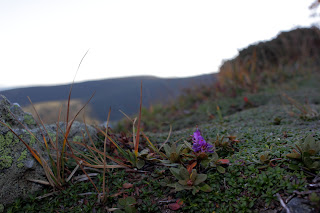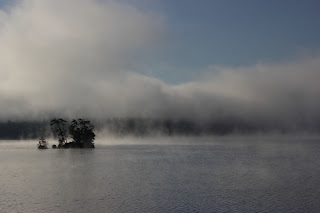 Three hours from my central Massachusetts home, the Appalachian mountain range rises. They're smaller than the Rockies, those beautiful white-capped crags of the central USA, but this is because the Appalachians are older; almost half a billion years old to the Rockies' 50 million. After being weathered down over all that time, the Appalachians are more like a series of high hills now. One particular hill in New Hampshire, Mount Washington, has a surprising reputation for a small mountain - it is ferocious! Though it is a "mere" 6,288 feet tall (Mt. Everest, the tallest on Earth, reaches 29,029 feet), the collision of various weather phenomena bring hurricane-force winds to Mount Washington on a regular basis; about a third of the year. In fact, the strongest winds ever observed by man* were recorded here - at 231 miles per hour. So I was no doubt excited to hike it when a friend mentioned it a few weeks ago.
Three hours from my central Massachusetts home, the Appalachian mountain range rises. They're smaller than the Rockies, those beautiful white-capped crags of the central USA, but this is because the Appalachians are older; almost half a billion years old to the Rockies' 50 million. After being weathered down over all that time, the Appalachians are more like a series of high hills now. One particular hill in New Hampshire, Mount Washington, has a surprising reputation for a small mountain - it is ferocious! Though it is a "mere" 6,288 feet tall (Mt. Everest, the tallest on Earth, reaches 29,029 feet), the collision of various weather phenomena bring hurricane-force winds to Mount Washington on a regular basis; about a third of the year. In fact, the strongest winds ever observed by man* were recorded here - at 231 miles per hour. So I was no doubt excited to hike it when a friend mentioned it a few weeks ago.Despite living nearby, I'd never visited; only vaguely heard about it from t-shirts, bumper stickers, and water cooler conversations. My hiking buddy told me that when she climbed last October, her group wore layers of winter clothing and were often too cold to take more than one photograph before looking for cover from the bone-chilling winds. Needless to say, being a fit, brave 25 year-old field biologist, I was excited to tackle the beast when we arrived in the morning. Fogs that hung over the morning landscape stoked the mystique of the coming adventure. We started up the Tuckerman Ravine Trail to the summit - a mere 4.4 miles that takes 4 hours to hike as it gains 4,000 feet in elevation over that distance.
Leafy green deciduous forest is the first to welcome us on the well-kept rocky paths. Dominating over evergreens at lower elevations and latitudes, these trees cast green and yellow hues on the trail, and pepper it with yellowed leaves during fall. Right away, you feel you are in deep wilderness. Though small towns are less than ten miles away, it is amazing what a distant world one can experience here. Located within the White Mountains National Forest, it is not the same as a National Park - extractive activities like logging are allowed throughout much of it. Yet about one fifth of this area is reserved for recreational and scientific purposes only - no logging.
As the altitude rises, deep-hued evergreens like pines and firs outcompete the broad-leafed deciduous trees. As the evergreens provide cover all year round, and precipitation is abundant, thick blankets of soft, spongy moss grow to cover the forest floor. It creeps even to the edges of the trail, and beckons to weary hikers looking for a comfortable place to nap. Many stretches of the trail weave so narrowly through this area that it becomes a sedate grotto - shielding the light, absorbing all sound but the occasional red squirrel's rolling chitter, and maintaining a brisk humidity. As we pass the trees in silence, we breathe in a deep aroma of the Christmas holiday - the powerful fir tree's terpene-laden resin - which triggers distant childhood memories...
Eventually, not even the evergreens can survive the high-altitude climate, and we enter the alpine zone. Here, there are no more trees to paint trail-marking "blazes" on, and instead piles of rocks called "cairns" are erected to note the location of the trail. Fragile alpine flowers like bluets, azalea, and rosebay bloom in this harsh area during the summer months, but as we've made the ascent in the fall, the majority of turf-like foliage between the rocks has turned hay yellow.
 |
| Lapland Rosebay (Rhododendron lapponicum), exposed hillside |
It becomes hard to follow a trail as we approach the summit itself; it appears to be nothing more than a pile of giant granite boulders covered in chartreuse lichens, littered with occasional cairns. Though only tenths of a mile are left, the constant hopping and climbing seem to yield no progress. But we totter on, and arrive at the top with exhausted ankles, calves, soles, and backs.
...Of course there are other ways to reach the summit, including a road and the zealously-touted "cog railway," which uses gears instead of wheels to climb the steep mountainside. Immediately our meditative solitude is invaded by bikers, families with prams, and cheeky French Canadians. After hours of muscle work, hydration, and contemplation, it is unsettling to say the least; we take our "I was there" summit picture, and move on.
 |
| Motorcycle tourists at the top |
 |
| Hydrating in a summit building |
 |
| Tomentose Burying Beetle (Nicrophorus tomentosus) |
Our return journey is even more surreal. We decide to take the Crawford Path down to the Davis Path to the Boott Spur trail. And the latter paths extend for a long way atop the alpine zone; a welcome spread of flat land to hike over that nonetheless feels like an alien landscape. Flaxen hay, white quartz-topped cairns, green lichens... And of course, our purple mountain majesties... When the trail dropped below the treeline once more, we had lost much sunlight. Navigating by shadows down endless cascades of yard-high boulders requires poise, and more breaks. We take our last snack at twilight on a mossy carpet, vision fading, reflecting on the day, before the last tenths of a mile take us to our car.
This blog tries to show you nature through my eyes. Yet to date, my gonzo journey across the natural world has been largely animal biased - and marine, at that. With all my background education in the marine sciences, this is no surprise. It was only when a fellow marine biologist brought spider babies into the lab once to look at under a microscope that I realized all life was peculiar. Yet this past Thursday showed me I've also been ignoring all those beautiful abiotic (i.e. nonliving) factors "nature" also implies; like landscapes. When you think of nature, what do you see, readers? For many, the idea of "nature" is "untouched wilderness" - a portrait that includes a beautiful landscape. (This untouched wilderness idea is a point of contention I'll expand on some other day; it's folly. We're animals too, we're just playing house.) To date, I've shunned such expansive outdoor adventures in the United States; I've always felt that I can see America when I'm too old/xenophobic/responsibility-laden to explore new countries anymore. Thus I've rarely explored my own country, despite knowing that there is great beauty to be found here. I'm saving it, like a fine wine; and exploring abroad now. But a side effect is that I lose the connection with my home country, not realizing it can be this beautiful; as beautiful as the Tibetan plateau. Although this is a story for another time, I joined others for a three-day hike in the foothills of the Himalayas outside Kathmandu, Nepal back in April of 2011. And although we were staring off into the distance at some of the world's highest peaks (the Langtang range reaches 20-23,000 feet high), I couldn't help but recall that view when standing on the edge of Mount Washington's Tuckerman Ravine, surveying the skyline.
 |
| Exploring the Langtang Range in Nepal with a Saudi friend in 2011. |










